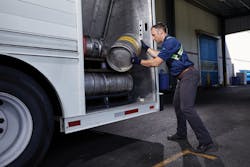We all know that overexertion injuries, mostly showing up as musculoskeletal injuries (MSIs), are a big problem, that is old news.
According to the 2019 Liberty Mutual Safety Index, injuries resulting from “overexertion and bodily reaction” are the most costly type of injury in the US, totaling $13.1 billion across all industries.
The direct costs of this injury category alone disproportionately affect industries like transportation and warehousing, where physical tasks such as pushing, pulling, lifting, and reaching, are just part of the job.
Humans have been trying to eliminate MSIs like these for years. To date, ergonomics has been the most common cure.
IN A NUTSHELL
Ergonomics is strictly defined as, “an applied science concerned with designing and arranging things people use so that the people and things interact most efficiently and safely” (emphasis mine). That’s a bit academic, so let’s just call it engineering the environment to the person. By virtue of engineering the environment to the human being, we can engineer some of the risk out of it, thus reducing the opportunity for injury.
Let’s think about a typical office environment. This is very applicable to individuals, like me, who sit at a desk in front of a screen for most of the day. Luckily, we’re familiar with common injury risks in the controlled environment of the office, so we’ve been able to use ergonomics to help mitigate them - to a degree.
I can buy a fancy ergonomic chair to potentially reduce the stress on my lower back, or I can get a hand-shaped mouse to alleviate wear and tear on my hands and wrist to prevent carpal tunnel and other ailments. Other solutions range from raising my monitor to eye-level, using a footrest, or even installing a standing desk. The list of engineering options goes on and on. However, other than making me look like I’m in a flight simulator, does this engineering guarantee you won’t get injured?
ERGONOMIC EFFECTIVENESS
A study by OSHA published in 2002 showed that, all else being equal, ergonomically engineering the environment eliminates 26% of “ergonomic related” injuries (their term) resulting in days away from work, over a ten-year period.
While roughly a quarter reduction or said differently, 1 out of every 4, is a good start, that still leaves a large portion, 74%, of “ergonomic related” injuries that won’t be affected by ergonomics. What can we do about those?
If we look at our simple definition of ergonomics, engineering the environment to the person, it doesn’t tell us anything about how the human body will actually interact with that engineering.
Let’s revisit the example of me sitting at my desk. I can buy the $800 ergonomic chair, but if I slouch over my keyboard all day long, then it’s not going to do me any good. My neck will still be sore, my back will still ache, and I may potentially end up with a lasting MSI.
It’s critical that I use my body to correctly interact with the engineering, or else I am not going to get the benefit from the engineering, rendering it useless.
Now let’s look at a delivery driver using a box truck with no lift gate as an example. We can add engineering, such as handles and steps, ramps, a hand cart, etc. to help make the job easier and reduce the risk of the driver being injured (Figure 1). However, even engineering can create added opportunity for injury if not used correctly, in this case while setting it up. This is a shoulder injury waiting to happen (Figure 2).
PROPER MOVEMENT MATTERS
Oftentimes, there’s no engineering available or appropriate for the job at hand. It just comes down to the team member and the task (or in this case the team member and the keg). No engineering, short of getting a robot to do the job, can completely eliminate the risk.
Millions of front line workers who do more than sit at a desk all day, such as delivery drivers, warehouse workers, linemen, nurses, or firefighters (just to name a few), are confronted with these kinds of scenarios on a daily basis. These individuals come across an infinite number of situations while they’re on the job. Ergonomics simply can’t be applied to this multitude of tasks and environments. Its effectiveness is largely limited to known environments, which leaves big opportunities for injury everywhere else.If engineering the risk out of the environment is only effective for 1 out of every 4 injuries, we need to focus on the only thing we can always control: the human being (Figure 3). By focusing on the human, specifically how they use their bodies to move through space and interact with their environments and the engineering we are able to put in place, we’re able to put them in stronger, more stable positions - reducing their risk in any situation.
At the end of the day, we aren’t creating superheroes, but we are working to reduce the risk of injury in the 1) known environments where we have been able to implement ergonomics by interacting with that engineering correctly, 2) in the known environments where we have not yet been able to implement ergonomics, and 3) in the circumstances and environments we have not yet encountered.
Movement matters!
About the Author
Ben Kanner
Ben Kanner is the co-founder and CEO of Worklete.



